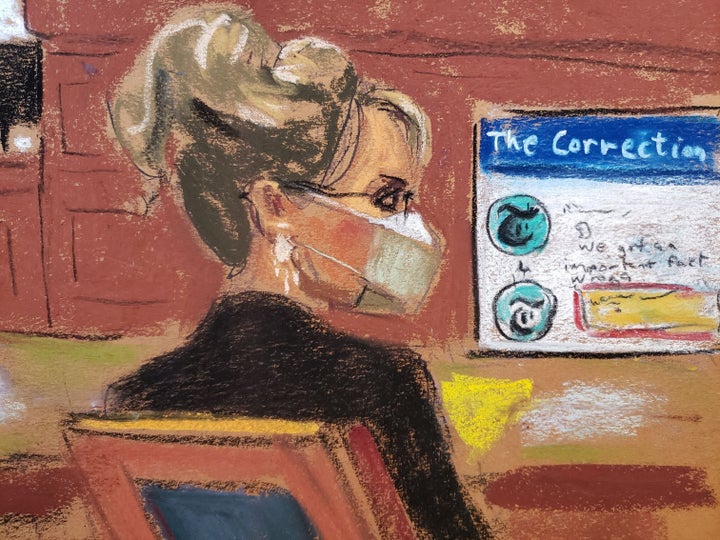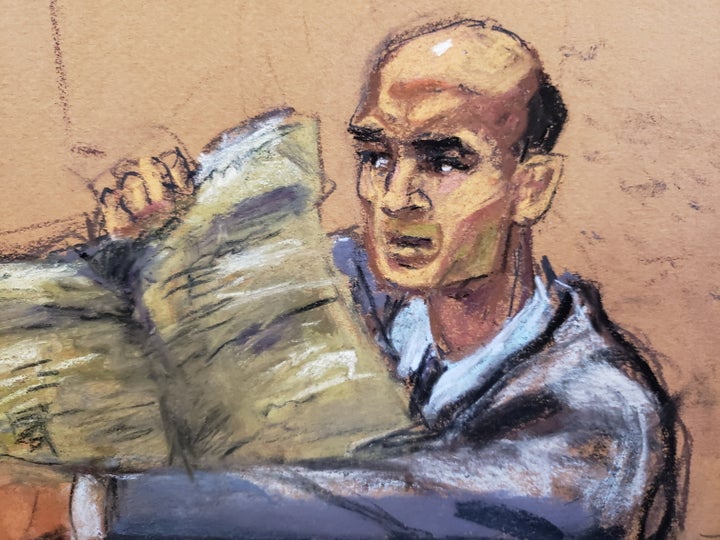
Former Alaska Gov. Sarah Palin (R) never had a particularly strong defamation case against The New York Times. Lawyers for both sides spent about a week last month going over what went wrong with a 2017 opinion piece in the paper erroneously linking Palin with an earlier mass shooting. To the Times, it was an honest mistake made under deadline pressure. To Palin, it was because editors at the newspaper were secretly biased against her.
A jury ruled unanimously for the Times. But the verdict was overshadowed by U.S. District Judge Jed S. Rakoff’s decision to toss the case if the jury did not decide in the newspaper’s favor ― an oddly timed announcement made as the jury was still deliberating. This week, Palin formally demanded a new trial.
Some of the jurors told the court that they’d actually found out what was happening in the case due to breaking news alerts they saw on their phones. They assured a bailiff that the notifications did not affect their decision.
Still, the judge fielded some criticism for his timing. Vanderbilt University law professor Gautam Hans told HuffPost he thought it “created wrinkles that didn’t need to be created.” Rakoff defended himself in a 68-page opinion filed Tuesday, writing that Palin’s team “wholly failed to prove her case even to the minimum standard required by law.” His job was to call out her side. It would have been “grossly unfair to both sides” to wait until after the jury reached a verdict, he wrote, because in the interim both Palin and the Times would be left thinking the case was going to be decided by the jury.
“While this approach was a bit unusual, neither side objected to it in the slightest,” Rakoff said of his decision’s timing. The jury was still allowed to deliberate on the assumption that Palin would appeal, and it would help the appellate court to know what a jury decided. Proceedings over Palin’s motion for a new trial ― and a new judge, among other requests ― are likely to unfold throughout March.
Legal experts, though, say the 2008 Republican vice presidential nominee still faces an uphill battle in her quest to extract damages from The New York Times. She is unlikely to be granted a new trial, and an appeals court seems unlikely to side with her if she seeks that route.
Clay Calvert, a law professor at the University of Florida and director of the Marion Brechner First Amendment Project, said an appellate court would rely heavily on Rakoff’s lengthy opinion to determine whether his judgment was flawed.
“I don’t think the odds are very good that the Second Circuit will reverse the decision,” Calvert said of the federal appellate court that handles New York cases.
But whether Palin wins her case in lower courts may not matter so much. Several people who spoke with HuffPost said they believed Palin’s case has always been bigger than one editorial.
“To me, it seemed to be as much about a media narrative, and the narrative about the media, as the law,” said Hans. “I think the idea that she was going to prevail at trial was unlikely, and yet the case didn’t settle. Why? Because I think they wanted to take it to trial, not necessarily so they would win in the trial court, but maybe for other legal or political ends.”

Testifying on the witness stand, Palin largely failed to craft a convincing picture of how the Times editorial had harmed her personally or professionally. She established that it was mortifying to be falsely linked to the 2011 Arizona mass shooting that killed six people and injured over a dozen. But after the editorial’s publication, she still managed to secure TV appearances on prominent shows and made public speeches to help galvanize Republican voters.
As long as her suit is pending, though, Palin has the opportunity to publicly accuse The New York Times of being a hotbed of anti-conservative bias, and to smear the establishment media at large.
Conservatives have long argued that it’s too hard to successfully sue the press in America. The “actual malice” standard that the Supreme Court adopted with 1964′s Times v. Sullivan ― a landmark First Amendment decision ― means that a public figure must prove someone either published something they knew to be false or that they recklessly disregarded the truth. It’s a high bar. Later cases expanded the definition of a public figure.
Some question whether Palin’s case is really just a vehicle for the Supreme Court to revisit the standard of actual malice. Two justices ― Clarence Thomas and Neil Gorsuch ― have already signaled they are open to it. But four justices need to agree to take on a case.
Calvert said he doubted the Supreme Court on the whole had the appetite for it, although he speculated that might have been the ultimate aim of Palin’s case. Hans also suggested that other pending cases could provide more efficient vehicles for revisiting actual malice.
John Watson, who teaches communications law and journalism ethics at American University, offered a differing viewpoint, saying he’d “bet my lunch money” at least four justices would agree to take Palin’s appeal, if it went that far, given the court’s strong conservative bias. He emphasized that the possibility was enough to raise concern.
“The stakes are pretty serious, particularly for professional journalists,” Watson said.
There is also the question of cost. It’s expensive to take a case to trial, let alone to the Supreme Court. Politico media writer Jack Shafer raised the idea that someone ― a rich conservative, perhaps ― was funding Palin’s lawsuit as a means of potentially rolling back press freedoms in America.
Slate noted that an “especially intriguing” figure had taken a seat in Rakoff’s courtroom throughout Palin’s trial: Charles Harder, the attorney who calls himself the “Gawker Slayer” for leading wrestler Hulk Hogan to victory in a lawsuit against the influential blog, which published Hogan’s sex tape.
Gawker was forced to shut down following a 2016 jury verdict in favor of Hogan, who was secretly receiving funding from billionaire Peter Thiel because the tech investor held a supposed grudge against the blog. (Politico asked Thiel for comment but received no reply, Shafer reported.) Palin is already represented by two attorneys who were part of Harder’s anti-Gawker legal team, the Florida-based Kenneth Turkel and Shane Vogt. It’s unclear whether anyone is helping her with legal fees.

Tanking the actual malice standard would be very bad news for the media, particularly for smaller organizations and local outlets already strapped for cash and steadily downsizing amid the media industry’s upheaval.
“If that fundamental concept of actual malice is set aside, coverage of people with power and influence would almost certainly have to decline,” Watson said.
“A bonafide effort to get the best evidence of the truth might not be enough,” he continued. “And realistically speaking, it might make serious coverage of important issues too expensive or too risky in terms of damages from a potential libel lawsuit.”
Of course, it’s not just the media that the actual malice standard protects. Members of the public who speak out are shielded, too.
“There’s all sorts of unintended consequences that would flow from a change in the status quo,” Hans said.
But there are reasons to believe Palin’s case is not ideal for such a challenge to First Amendment press freedoms. Her suit is not especially compelling — Judge Rakoff threw it out in 2017 over a procedural matter. It was restored on appeal and made its way to trial, where both Rakoff and a jury came to the conclusion that Palin didn’t have enough on her side.
Hans theorized that other legal vehicles might be better positioned to challenge the actual malice standard, such as the dispute that emerged after the Southern Poverty Law Center dubbed an evangelical church, Coral Ridge Ministries, a hate group.
A New York state law may also throw a wrench into Palin’s case. New York adopted the actual malice standard on its own in 2020, and according to Reuters, Rakoff ruled that law would apply in Palin’s case. State law could also act as a guardrail on defamation lawsuits more broadly.
“Even if the court scrapped actual malice as to public figures, states could still adopt their own standards,” Calvert said. “What the Supreme Court is doing ... it’s just setting the First Amendment minimum, or floor.”
